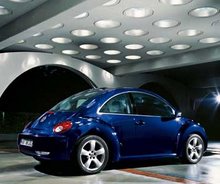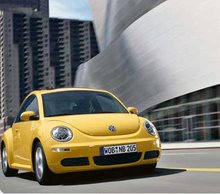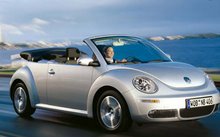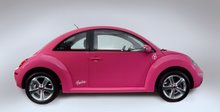Wednesday, March 21, 2007
Pop culture
Like its contemporaries, the Mini and the Citroën 2CV, the Beetle has been regarded as something of a "cult" car since its 1960s association with the hippie movement and surf culture; and the obvious attributes of its unique and quirky design. (For example, the Beetle could float on water - for a little while-thanks to its sealed floor pans and overall tight construction.) Much like their Type 2 counterparts, Beetles were psychedelically painted and considered an art car ancestor. One of the logos used by the Houston Art Car Klub incorporated a Beetle with a cowboy hat.
The Beetle has made numerous appearances in Hollywood films, most notably The Love Bug comedy series (Disney) from 1968 to 2005, starring as "Herbie", a pearl-white, fabric-sunroofed 1963 Beetle - racing number 53. The opening aerial shot of Stanley Kubrick's The Shining (1980) follows a yellow Volkswagen Beetle. The Arrival (1996, science fiction) featured a few Mexican Beetles in the film (in one scene Charlie Sheen hides in the notoriously cramped trunk of a Beetle). In Woody Allen's Sleeper (1973), a Volkswagen is still able to start after having been abandoned in a cave for 200 years (Allen: "They really built these things, didn't they?"). In the comedy hit What's Up, Doc? (1972), Ryan O'Neal and Barbra Streisand, after a climactic car chase, end up floating in San Francisco Bay in their Beetle (see note on construction, previous paragraph).
In an episode of the Nickelodeon TV show Drake and Josh, Megan suggests that they buy a 1960s-70s Beetle with a beach themed body.Later in the episode, Megan demands that the boys buy the Beetle in order to avoid being trapped in the closet of an orangutan eater's home. A yellow Wunderkäfer, called DuDu, appeared in a series of German films for children. Also made famous is the Autobot Bumblebee, a canary yellow Beetle in the toy, comic and cartoon line The Transformers. The Throttlebot, Legends and Generation 2 toy line versions of Bumblebee also transformed from robot to VW Beetle, though the Throttlebot-type was called Goldbug as it was a golden 1975 Super Beetle. (Note, too, that the G2 toy was painted anodized gold in colour.) In other countries, 'Bumblebee the Beetle' has been released in various colours.
During the early 1970s, the Beetle was used for advertisements where graphic art ads were decaled on newly-sold Volkswagens. A marketing consultant (Charlie E. Bird) in the Los Angeles area came up with the "Beetleboard" concept. Both standard and Super Beetles were used, until the original Beetle ceased production in Europe in 1978. This trend was resurrected after the New Beetle entered production (source - The Beetle Book).The Volkswagen Beetle has built a large fan base among off-road types in the form of the Baja Bug. Today, there are many online clubs and communities that keep Beetle aficionadoes on touch. Even the sighting of a Volkswagen Beetle is cause for violent fun in the car-sighting game known as "Slug-Bug" or Punch Buggy.
The Beetle is also one of the most commonly reproduced cars as a toy or model of all sizes. Hot Wheels and Matchbox produced many near stock and outrageously styled and customized drag racing and modified dune buggy beetles. Most manufacturers of toy cars have included a Beetle in their line at one time or another.
In Episode 2 of the anime Jigoku Shoujo, the stalker of the high school girl escaped being beaten up by his father in what appears to be a Volkswagen Beetle.
The Volkswagen Beetle also made a major appearance in the anime movie Nasu: Summer in Andalusia. It was a red Cabriolet chasing Pepe, the main character, with his family on board.
Kids in the Philippine province of Ilocos Sur would race to slap each other upside the head and/or salute at the sight of a Volkswagen Beetle or Brasilla.
The Beetle has made numerous appearances in Hollywood films, most notably The Love Bug comedy series (Disney) from 1968 to 2005, starring as "Herbie", a pearl-white, fabric-sunroofed 1963 Beetle - racing number 53. The opening aerial shot of Stanley Kubrick's The Shining (1980) follows a yellow Volkswagen Beetle. The Arrival (1996, science fiction) featured a few Mexican Beetles in the film (in one scene Charlie Sheen hides in the notoriously cramped trunk of a Beetle). In Woody Allen's Sleeper (1973), a Volkswagen is still able to start after having been abandoned in a cave for 200 years (Allen: "They really built these things, didn't they?"). In the comedy hit What's Up, Doc? (1972), Ryan O'Neal and Barbra Streisand, after a climactic car chase, end up floating in San Francisco Bay in their Beetle (see note on construction, previous paragraph).
In an episode of the Nickelodeon TV show Drake and Josh, Megan suggests that they buy a 1960s-70s Beetle with a beach themed body.Later in the episode, Megan demands that the boys buy the Beetle in order to avoid being trapped in the closet of an orangutan eater's home. A yellow Wunderkäfer, called DuDu, appeared in a series of German films for children. Also made famous is the Autobot Bumblebee, a canary yellow Beetle in the toy, comic and cartoon line The Transformers. The Throttlebot, Legends and Generation 2 toy line versions of Bumblebee also transformed from robot to VW Beetle, though the Throttlebot-type was called Goldbug as it was a golden 1975 Super Beetle. (Note, too, that the G2 toy was painted anodized gold in colour.) In other countries, 'Bumblebee the Beetle' has been released in various colours.
During the early 1970s, the Beetle was used for advertisements where graphic art ads were decaled on newly-sold Volkswagens. A marketing consultant (Charlie E. Bird) in the Los Angeles area came up with the "Beetleboard" concept. Both standard and Super Beetles were used, until the original Beetle ceased production in Europe in 1978. This trend was resurrected after the New Beetle entered production (source - The Beetle Book).The Volkswagen Beetle has built a large fan base among off-road types in the form of the Baja Bug. Today, there are many online clubs and communities that keep Beetle aficionadoes on touch. Even the sighting of a Volkswagen Beetle is cause for violent fun in the car-sighting game known as "Slug-Bug" or Punch Buggy.
The Beetle is also one of the most commonly reproduced cars as a toy or model of all sizes. Hot Wheels and Matchbox produced many near stock and outrageously styled and customized drag racing and modified dune buggy beetles. Most manufacturers of toy cars have included a Beetle in their line at one time or another.
In Episode 2 of the anime Jigoku Shoujo, the stalker of the high school girl escaped being beaten up by his father in what appears to be a Volkswagen Beetle.
The Volkswagen Beetle also made a major appearance in the anime movie Nasu: Summer in Andalusia. It was a red Cabriolet chasing Pepe, the main character, with his family on board.
Kids in the Philippine province of Ilocos Sur would race to slap each other upside the head and/or salute at the sight of a Volkswagen Beetle or Brasilla.
Subscribe to:
Post Comments (Atom)




No comments:
Post a Comment